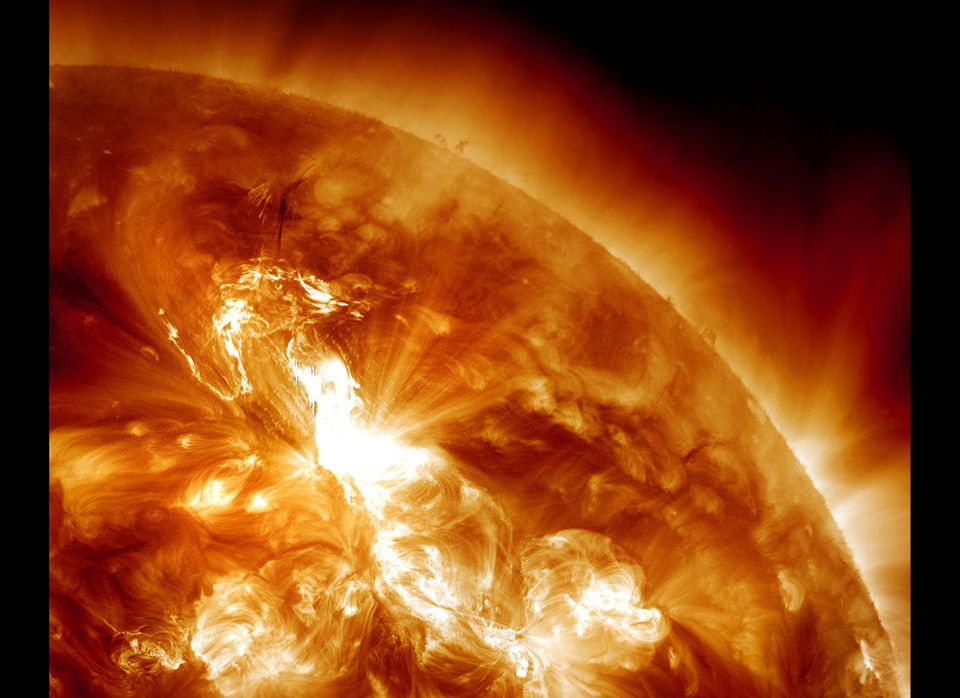What actually happens during a solar storm? How do sunspots, flares, and coronal mass ejections relate to one another? And what's the real effect the sun's violent surface can have on us, here on Earth?
I spoke to Phil Plait, "The Bad Astronomer," seeking answers. Watch the video above and click the link below to learn more. And don't forget to leave a comment at the bottom of the page. Come on, talk nerdy to me!
PHIL PLAIT: A solar storm is an eruption on the sun and it’s not exactly like a storm on the Earth where just the Earth’s atmosphere acts up. When there’s a storm on the sun, it’s a huge, explosive event. And it can actually have effects that can hit us here on Earth.
CARA SANTA MARIA: Hi everyone. Cara Santa Maria here. And that's Phil Plait. He writes the Bad Astronomy blog at Discover.com. He's also the author of Death From The Skies: These Are The Ways The World Will End. I spoke with him about our sun, and what its violent storms are really capable of.
PP: The sun is basically a giant ball of hydrogen. Yeah, there’s some helium in it and carbon and oxygen and little dashes of other flavors, but it’s mostly just a big ball of hydrogen, and it’s a gas in that it’s not a solid or liquid, but it’s a special kind of gas called a plasma, and a plasma is when atoms have one or more of its electrons stripped off of it and when that happens, when something’s very hot and it's a plasma, it can be affected by magnetic fields, and that’s why the sun is so active.
CSM: The sun's core is an incomprehensible 27 million degrees Fahrenheit. It's a massive nuclear fusion plant, and every second, it releases the same energy as ten billion hydrogen bombs! Some of that energy can manifest as solar flares and coronal mass ejections.
PP: If a solar flare is a tornado, very intense, very focused, very local, a coronal mass ejection is a hurricane. Much larger, huge amounts of energy and they affect a bigger volume of space.
CSM: The interesting thing is, these events don't just occur at random. There's some method to the sun's madness, even if we don't understand exactly what causes it yet.
PP: Ever since the invention of the telescope we’ve seen spots on the sun and if you count them up, if you look at how many there are at any given time, you’ll see that over time, over years, that number gets bigger and smaller. On about an 11-year cycle. So you have a big number, and then five and a half years later it drops down to zero, and then five and a half years later it goes back up again. Eleven years from maximum to maximum. We call this the sunspot cycle. Now that’s tied into the sun’s magnetic fields, since the sunspots are a magnetic phenomenon, that means the sun’s magnetic field is getting stronger and weaker over the course of these 11 years.
CSM: And you guessed it, we're headed for another peak in the solar cycle in 2013. But is it really all doom and gloom? What impact can these solar storms have on us here on Earth?
PP: These things are a risk. The risk is real. We could lose satellites, we could lose GPS, we could lose communication that way, and that would be bad. We could have widespread blackouts, but that it would take a very large event that has to connect with us in a very certain way. So it’s not like this is going to happen every solar cycle. It doesn’t happen that much, it’s something we should be concerned about, but not something we should be ‘baah!’ panicking and running around and screaming about.
CSM: Well, that's comforting. And Phil reminds us:
PP: One thing to remember is we’ve had the sun around for a long time. The difference now is we are a technological society. We depend on electricity, we depend on the Internet. So we have to be more careful about how we observe the sun, what we can learn about it, the important thing is that it brings us all of our light, all of our heat, and we depend on it to survive. We just have to understand it better if we’re going to survive in the modern era. After all, hey you know, I heart heliocentrism baby!
CSM: Do you heart heliocentrism? Sound off on Twitter, Facebook, or leave a comment right here on The Huffington Post. Come on, Talk Nerdy To Me!
See all Talk Nerdy to Me posts.
Like Cara Santa Maria on Facebook.
Follow Cara Santa Maria on Twitter.
